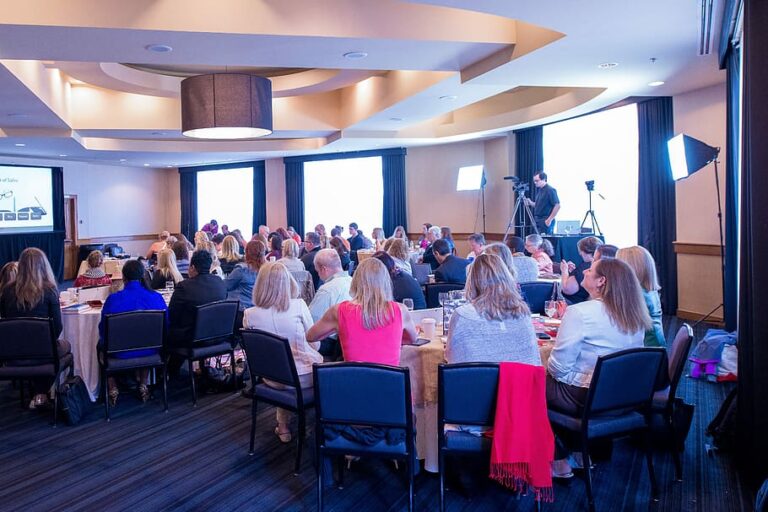Conference marketing is the art of promoting and publicizing an event to attract attendees, sponsors, and speakers. In today’s digital age, where information overload is common, event organizers need effective strategies to cut through the noise and reach their target audience. In this blog, we’ll explore nine proven conference marketing strategies that can help organizers boost attendance, enhance engagement, and maximize the success of their events.
9 Conference Marketing Strategies to Boost Attendance
1. Utilize Social Media Platforms Effectively
Social media platforms like Facebook, Twitter, LinkedIn, and Instagram offer powerful tools for promoting conferences. Create dedicated event pages or profiles across these platforms to share event details, updates, speaker announcements, and engaging content. Encourage attendees to interact by asking questions, running polls, and sharing user-generated content related to the event. Leverage hashtags to increase visibility and encourage attendees to share their experiences before, during, and after the conference.
2. Implement Email Marketing Campaigns
Email marketing remains a highly effective tool for promoting conferences and engaging with potential attendees. Build targeted email lists segmented by demographics, interests, and past attendance. Craft personalized and compelling email content, including event highlights, early bird offers, speaker profiles, and exclusive updates. Use automated email sequences to nurture leads, send reminders, and follow up post-event for feedback and future promotions.
3. Leverage Content Marketing Strategies
Content marketing can create buzz and generate interest in your conference. Create valuable content such as blog posts, infographics, videos, and podcasts related to industry trends, conference themes, and speaker insights. Distribute this content across your website, social media platforms, and email newsletters to attract and engage your target audience. Collaborate with speakers, sponsors, and influencers to co-create and amplify content reach.
4. Partner with Influencers and Industry Leaders
Influencers and industry leaders can significantly impact conference attendance and credibility. Identify relevant influencers in your industry or niche and collaborate with them to promote your event to their followers. Offer them speaking opportunities, sponsorships, or exclusive access in exchange for promotion. Their endorsements and engagement can significantly expand your event’s reach and attract new audiences.
5. Optimize SEO for Increased Visibility
Search engine optimization (SEO) is crucial for ensuring your conference website and content rank well in search engine results. Conduct keyword research to identify relevant keywords and phrases related to your event, industry, and target audience. Optimize your website content, meta tags, headings, and image alt text with these keywords. Create valuable backlinks from reputable websites, directories, and industry platforms to boost your website’s authority and visibility.
6. Utilize Paid Advertising Channels
Paid advertising can complement organic marketing efforts and reach a wider audience quickly. Consider running targeted ads on platforms like Google Ads, Facebook Ads, LinkedIn Ads, and industry-specific platforms. Use precise targeting options based on demographics, interests, behaviors, and remarketing to reach potential attendees effectively. A/B test ad creatives, messaging, and landing pages to optimize ad performance and conversion rates.
7. Offer Early Bird and Group Discounts
Entice potential attendees to register early by offering attractive early bird discounts and incentives. Create urgency by highlighting limited availability or early bird deadlines. Additionally, offer group discounts for teams or organizations registering multiple attendees. Leverage scarcity and exclusivity to encourage prompt registration and boost overall attendance numbers.
8. Provide Value Through Engaging Event Content
Deliver value-packed content and experiences throughout your conference marketing strategies journey. Offer free webinars, workshops, or virtual meetups leading up to the event to showcase speakers, topics, and event highlights. Create teaser content such as speaker interviews, behind-the-scenes glimpses, and attendee testimonials to build excitement and anticipation. During the event, provide valuable sessions, networking opportunities, and interactive experiences that keep attendees engaged and satisfied.
9. Implement Post-Event Follow-Up and Engagement
The end of the conference doesn’t mark the end of your marketing efforts. Follow up with attendees, sponsors, and speakers to gather feedback, testimonials, and insights. Share post-event highlights, recordings, and resources with attendees to reinforce value and encourage future participation. Nurture ongoing relationships with your audience through email newsletters, social media engagement, and exclusive offers for upcoming events.
Conclusion
Effective conference marketing Strategies require a strategic blend of digital marketing tactics, content creation, influencer partnerships, and attendee engagement strategies. By leveraging the power of social media, email marketing, content marketing, SEO, paid advertising, discounts, valuable content, and post-event follow-up, event organizers can boost attendance, enhance engagement, and ensure the success of their conferences in today’s competitive landscape.
Continuously analyze data, gather feedback, and iterate on marketing strategies to improve outcomes and create memorable conference experiences for attendees and stakeholders alike.

